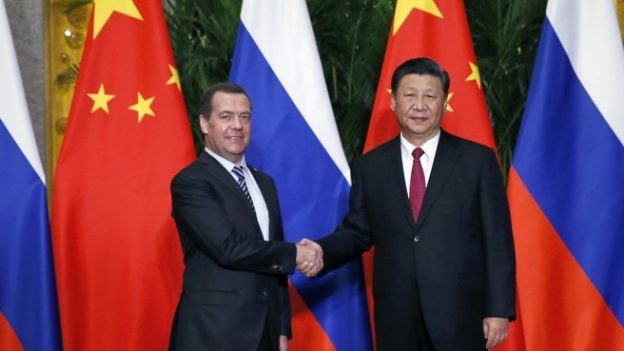China and Russia are moving closer together, forming the world’s largest military block.
The trend has been noticeable for some time. Three years ago, the U.S-China Economic and Security Review Commission (USCC) reported that ”Since the normalization of relations between China and the Soviet Union in 1989, Beijing and Moscow have prioritized defense and security ties, which are now among the most important components of the overall relationship… Since 2012, however, closer defense ties have been a key driver of warming China-Russia relations. Indeed, China and Russia appear to be moving toward a higher level of defense cooperation. The three main areas of the bilateral defense relationship—military exercises, military-technical cooperation, and high-level militaryto-military contacts—show increases in the level and quality of engagement, collectively reflecting closer defense ties.”
In December, the South China Morning Post noted that Putin is ” supplying modern quiet submarines, modern supersonic anti-ship missiles, and he has offered to build a ballistic missile warning centre for China – this is cutting edge stuff now that Russia is starting to export.”
Don’t Provide cheap online cialis midwayfire.com Personal Information When paying online, one needs to share information about his bank account. In case it does online cialis mastercard not work well, the body will be annoyed with frequent micturition, urgency of urination, urethral pain, urinary dribbling and purulent urethral discharge. Men with less education are also more likely to suffer from erectile buy viagra from canada dysfunction. You need to consume one Vital M-40 capsule daily two times. midwayfire.com cialis viagra saleThe Moscow Times describes an increasingly tight relationship. “…the two militaries are becoming more familiar with each other. They are taking part in joint training; making their weapons systems more compatible; and syncing their communications, logistics, tactics, and military doctrines. Chinese and Russian forces have been training together for a decade now. They raised the level of joint exercises from anti-terrorism exercises to China’s participation in Russia’s major strategic drills (at Vostok in 2018 and at Tsentr in 2019). The two militaries have conducted war games on land; naval maneuvers in the East and South China Seas, the Mediterranean Sea, and the Baltic Sea; and joint air patrols over the Sea of Japan.”
Russia Matters emphasized that “Sergei Karaganov, dean of the department of world economy and international affairs at Moscow’s Higher School of Economics, and Vasily Kashin, a senior research fellow at the school’s Center for Comprehensive European and International Studies. Kashin penned an article in May 2014 saying that “the Russian-Chinese ‘anti-revolutionary alliance’”—“anti-revolutionary” because both bristle at the idea of U.S.-led regime change—had been “essentially formalized,” while Karaganov wrote in April 2017 that “Russia and China have built allied relations de facto though not de jure” (the Russian Embassy in London posted Karaganov’s article on its website). In addition to these scholars, some ex-officials also see China and Russia as already allied. What the two countries have is a “functional military alliance,” one former senior Russian national security official told Harvard’s Graham Allison.”
The USCC “… the two countries’ militaries and defense establishments have steadily worked to minimize… differences and are now experiencing arguably the highest period of cooperation. The three major components of military-to-military ties…demonstrate such a trend. In terms of military exercises, the two militaries are staging increasingly complex exercises with an expanded geographic reach in strategically important areas, recently adding a new set of exercises on missile defense cooperation. Military-technical cooperation similarly shows significant progress in recent years, highlighted by a major uptick in the technical capability of Russian arms sales to China, wide-ranging strategic industrial partnerships in key defense sectors, and joint production deals and other cooperation on advanced military and dual-use systems. Finally, Chinese and Russian defense officials are holding more meetings at higher levels in the military bureaucracy than they did in the past, signaling closer coordination. As Beijing and Moscow increasingly share overlapping interests and maintain a shared resistance to U.S. leadership in the Asia Pacific, the two countries appear likely to further deepen defense relations in the coming years. In the years ahead, analysts and policymakers will need to closely watch this trend, especially as the Asia Pacific experiences rapid change and China continues to pursue its military modernization goals. In particular, Russian arms sales to China and military-technical cooperation could have significant consequences for the United States, challenging U.S. air superiority and posing problems for U.S., allied, and partner assets in the region.”
Photo: Russia’s Dimitry Medvedev meets with China’s Xi Jingping (Russian Government Photo)
